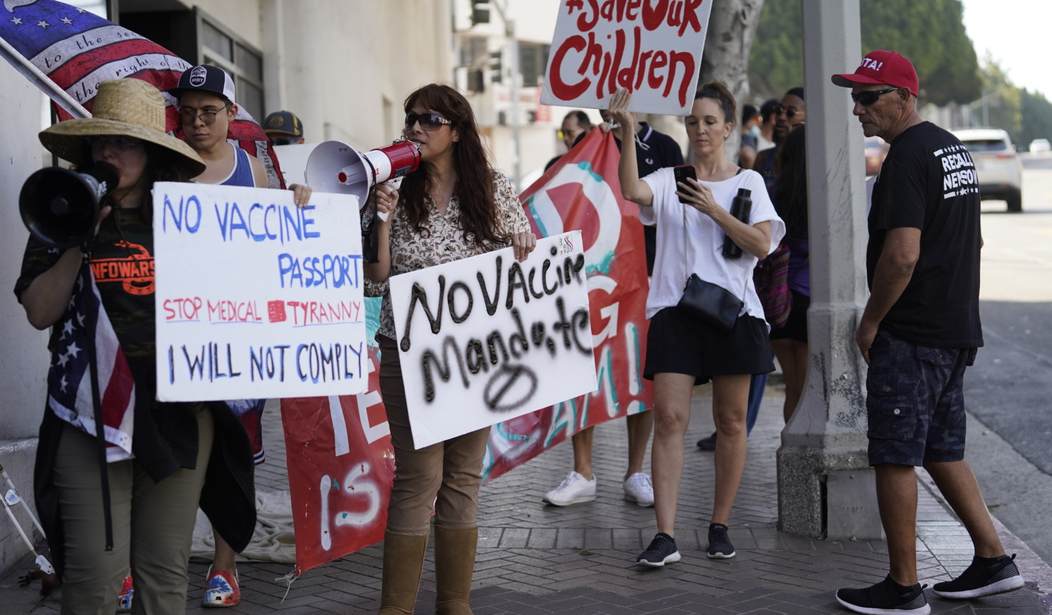Last week, Anthony Fauci, President Joe Biden's top infectious disease adviser, said the federal government should consider requiring that domestic air travelers be vaccinated against COVID-19. "When you make vaccinations a requirement," he explained, "that's another incentive to get more people vaccinated."
Although requiring vaccination of airline passengers ostensibly would be aimed at making air travel safer, Fauci sees it as a way to boost the U.S. vaccination rate. The Biden administration sees its vaccination rule for private employers, which ostensibly is aimed at addressing a workplace hazard, the same way.
The contrast between that broader goal and the legal justification for the employer mandate is at the center of the debate about whether the Occupational Safety and Health Administration has the authority to impose it. That debate comes to the Supreme Court on Friday, when the justices will consider whether the mandate should be blocked until the challenges to it are resolved.
OSHA's rule, which it published on November 5, demands that companies with 100 or more employees require them to be vaccinated or wear face masks and undergo weekly virus testing. When Biden announced that policy in September, he presented it as part of the administration's plan for "vaccinating the unvaccinated."
MSNBC anchor Stephanie Ruhle called OSHA's mandate "the ultimate work-around for the Federal govt to require vaccinations." White House Chief of Staff Ron Klain retweeted Ruhle's comment, reinforcing the impression that the rule aims to reduce the overall impact of COVID-19 by pressuring Americans to get vaccinated.
But OSHA has no such authority. Officially, its rule is an "emergency temporary standard" that is "necessary" to protect employees from a "grave danger" in the workplace.
Recommended
That characterization, if accepted by the courts, allows OSHA to exercise the sort of public health powers that are ordinarily reserved to the states. It also allows the agency to issue regulations that take effect immediately, without the notice, public comments and hearings that are usually required.
The U.S. Court of Appeals for the 5th Circuit, which stayed the ETS the day after it was published, said it "grossly exceeds OSHA's statutory authority." But after the challenges to the mandate were consolidated and assigned to the U.S. Court of Appeals for the 6th Circuit, a divided three-judge panel lifted the 5th Circuit's stay, which is how the case ended up at the Supreme Court.
OSHA's sudden decision to invoke its "emergency" powers, nearly two years after the pandemic began and a year after vaccines became available, seems dubious. So does its preference for vaccination, which, unlike other workplace safety measures, is not limited to the workplace. Tellingly, OSHA's estimate of its rule's benefits is based on deaths prevented by vaccination of working-age Americans, regardless of where transmission occurs.
OSHA has never before required or encouraged employers to make vaccination mandatory, even when it issued a COVID-19 ETS for the health care industry in June and when it addressed bloodborne pathogens through the usual rule-making process. Both of those standards dealt with situations where employees faced increased disease risks because of the nature of their work -- treating COVID-19 patients and handling biological specimens, respectively.
The vaccine-or-testing requirement, by contrast, applies to 84 million employees -- two-thirds of the workforce -- in myriad industries and workplaces, with little regard to how COVID-19 risk varies across them. And it exempts companies that employ fewer than 100 people, as if the risk of COVID-19 transmission disappears below that threshold.
That is not the only puzzling distinction drawn by OSHA. According to the government's data, middle-age workers who are vaccinated face about the same COVID-19 risk as younger workers who are not vaccinated. According to OSHA, however, COVID-19 poses a "grave danger" to the latter group but not to the former.
It certainly looks like the Biden administration is trying to disguise a general vaccine mandate as a workplace safety measure. The Supreme Court will ultimately decide how convincing that disguise is.
Jacob Sullum is a senior editor at Reason magazine. Follow him on Twitter: @JacobSullum. To find out more about Jacob Sullum and read features by other Creators Syndicate writers and cartoonists, visit the Creators Syndicate webpage at www.creators.com.

























Join the conversation as a VIP Member